The Effects of Hydropower Plants on the Physicochemical Parameters of the Bystrzyca River in Poland
Abstract
1. Introduction
2. Materials and Methods
2.1. Field Studies
2.2. Laboratory Tests
2.3. Statistical Analysis
- related to basic statistics (Statistica software);
- boxplots with minimum, maximum, mean, median, 25th and 75th percentiles and outliers (Origin software);
- Hierarchical cluster analysis (HCA) and principal component analysis (PCA) in the following variants: relationships between research points within the tested physicochemical parameters, physicochemical parameters at each research point, observations within each parameter (Origin software);
- general linear model (nonparametric): intragroup analysis of variance (ANOVA) for repeated measurements in the following variants: analysis for each parameter separately between eigenvalues on the Bystrzyca river, without point 8 (points 2–7, 9, and 12–15; joint research performed for 24 months; omission of point 8 results from the location in the canal parallel to the main tested watercourse—points 6 and 7; taking this point into account would cause erroneous analysis results), analysis of each HP separately above and below each hydropower facility (points 2 and 3, 6 and 7, 13 and 14; for the Marszowice HP a 36-month period) and taking into account the reference points (points 2, 3 and 4; 6, 7; 12–15—2 years and 13–15—3 years); such a model was chosen due to the number of repeated measurements less than 100, and the fact that in such an analysis the results can be compared in the most reliable way, taking into account their temporal and spatial variability, as well as the impact of each parameter on the results; within the model, the significance for the Mauchly sphericity test was checked and in the case of significance p < 0.05 (sphericity was found), the significance for the Greenhouse‒Geisser test (selected due to its conservativeness) was checked, and then, if the result was significant, a comparison in pairs between points above and below HPs (2 and 3, 6 and 7, and 13 and 14); if the test was found to be aspherical (p > 0.05), the significance for the assumed sphericity was checked, and the subsequent steps were analogous to the above (SPSS software).
2.4. Interpretation and Discussion of the Results
3. Results and Discussion
3.1. Cumulative Results for Points above HPs, below HPs, and Reference Points
3.2. Within-Group Analysis of Variance for Repeated Measures—ANOVA
3.3. Analysis of the Variability of Results for Statistically Significant Parameters
3.3.1. Electrolytic Conductivity (EC)
3.3.2. Nitrate Nitrogen (NO3-N)
3.3.3. Dissolved Oxygen (DO)
3.3.4. pH
3.3.5. Total Phosphorus (TP)
3.4. Cumulative Effect of Hydropower Plants on the Tested Physicochemical Parameters
3.5. The State of Physicochemical Elements at the Tested Measuring Points (Water Quality)
3.6. Requirements for the Living Conditions of Aquatic Organisms
3.7. Other Factors Influencing the Physicochemical Status of the Bystrzyca River
4. Conclusions
- (1)
- The investigated HPs influence the selected physicochemical parameters of water (Section 3.1 and Section 3.2).
- (2)
- On the scale of the studied section of the Bystrzyca River, the following parameters changed statistically significantly: EC (effect size 0.924), NO3-N (0.541), DO (0.322), pH (0.310), and TP (0.179) (Table 5).
- (3)
- A statistically significant effect (p < 0.05) was found for the Skałka HP (EC and pH) and Marszowice (EC, NO3-N, DO, pH, and NH4-N) (Section 3.2).
- (4)
- Statistically significant and higher than 5% impact within the Marszowice HP on the following parameters: NH4-N (decrease below the HP by 27.83%), DO (increase by 14.0%), and NO3-N (increase by 5.5%) (Table 6).
- (5)
- Taking into account our results and those from the literature review, we see that the scale of the impact of HPs is influenced by their type and water level. The higher the damming height, the greater the impact on the values of physicochemical parameters (the damming heights of the Marszowice, Skałka, and Sadowice HPs are, respectively, 3.75, 2.2, and 1.8 m; five, two, and zero parameters changed significantly within the HPs) (Table 6 and Table 7).
- (6)
- It was found that run-of-river HPs have less impact on physicochemical parameters than reservoir ones and this is more important than the damming height (e.g., change of TP below HPs: reservoir HP, with a damming height of 5–15 m = −26.97%, run-of-river HP, damming height 243 m = −28.0%, run-of-river HPs below 5 m = −7.22 to −0.19%) (Table 7).
- (7)
- Our results corroborate the results of other scientists in terms of an increase in dissolved oxygen below hydropower facilities, a decrease in conductivity, and a decrease in TP concentrations. The results for turbidity, NO3-N, and TN are partially different (decreases in other tests, negative and positive values in our own tests, but usually they are not statistically significant) (Section 3.4).
- (8)
- HPs should be tested each time within the barrages on which they are located. Research has shown that HPs have little impact on the shaping of water quality over a larger time and spatial scale (longitudinal profile of the watercourse) (Section 3.3 and Appendix A), where a greater role may be played by the use of the river basin, the applicable political system, and environmental requirements (e.g., in agriculture and water protection) (Section 3.7).
- (9)
- There were no significant differences in the impact of HPs on physicochemical parameters in the context of the assessment of their condition (water quality classification) and in terms of meeting the requirements for the life of aquatic organisms. The results were similar above and below hydropower facilities (Section 3.5 ).
Author Contributions
Funding
Data Availability Statement
Conflicts of Interest
Appendix A
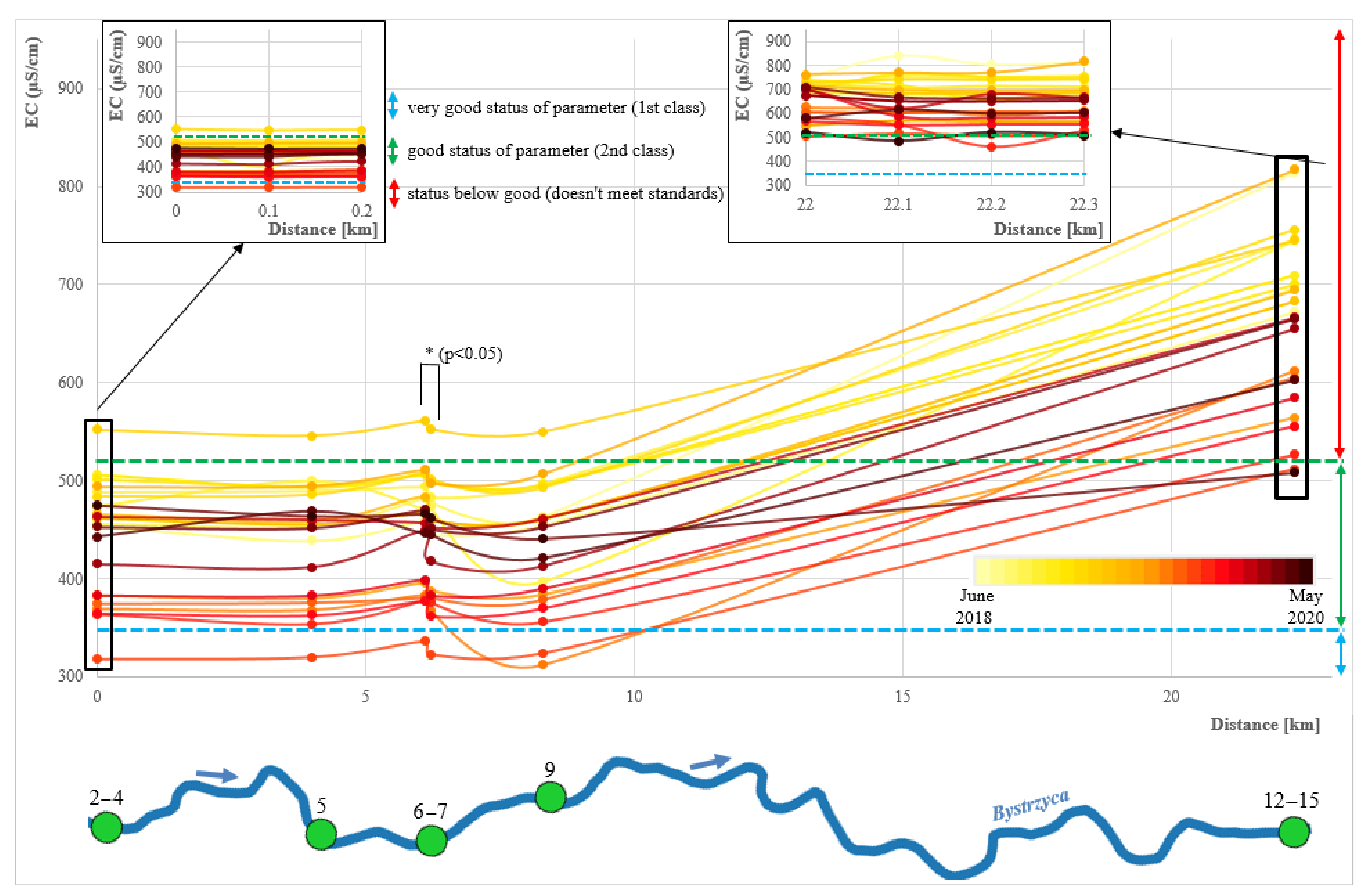
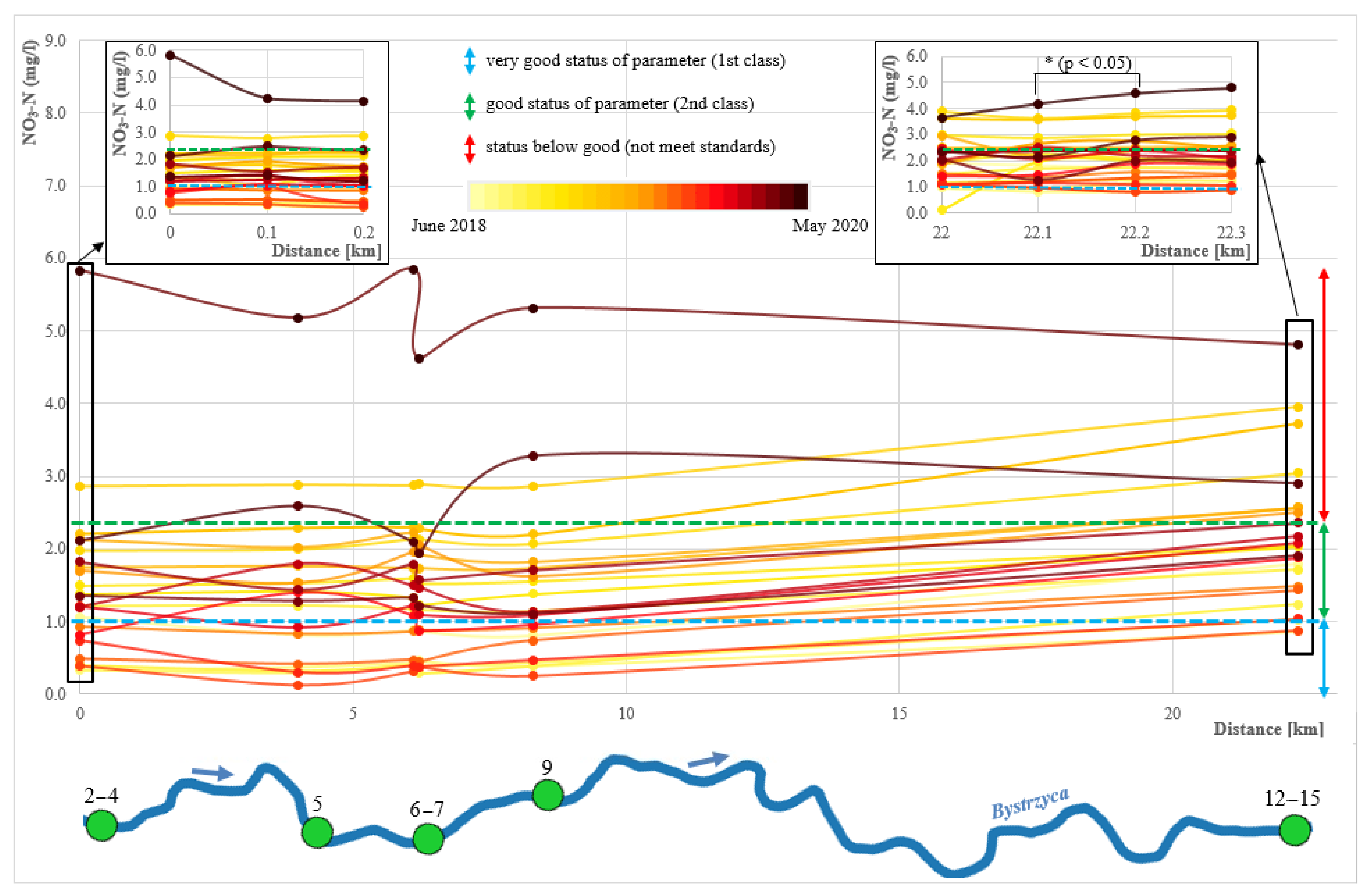

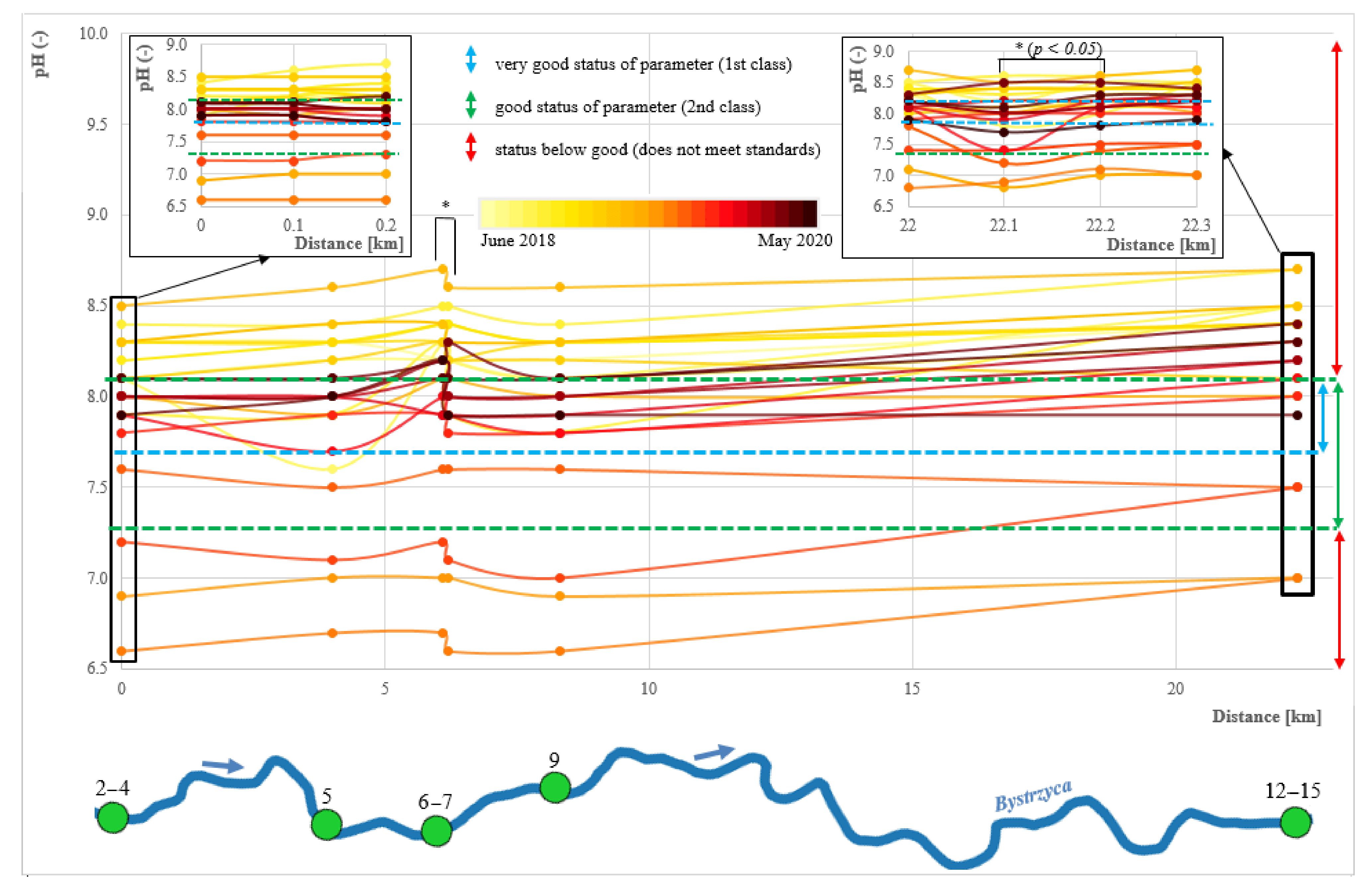
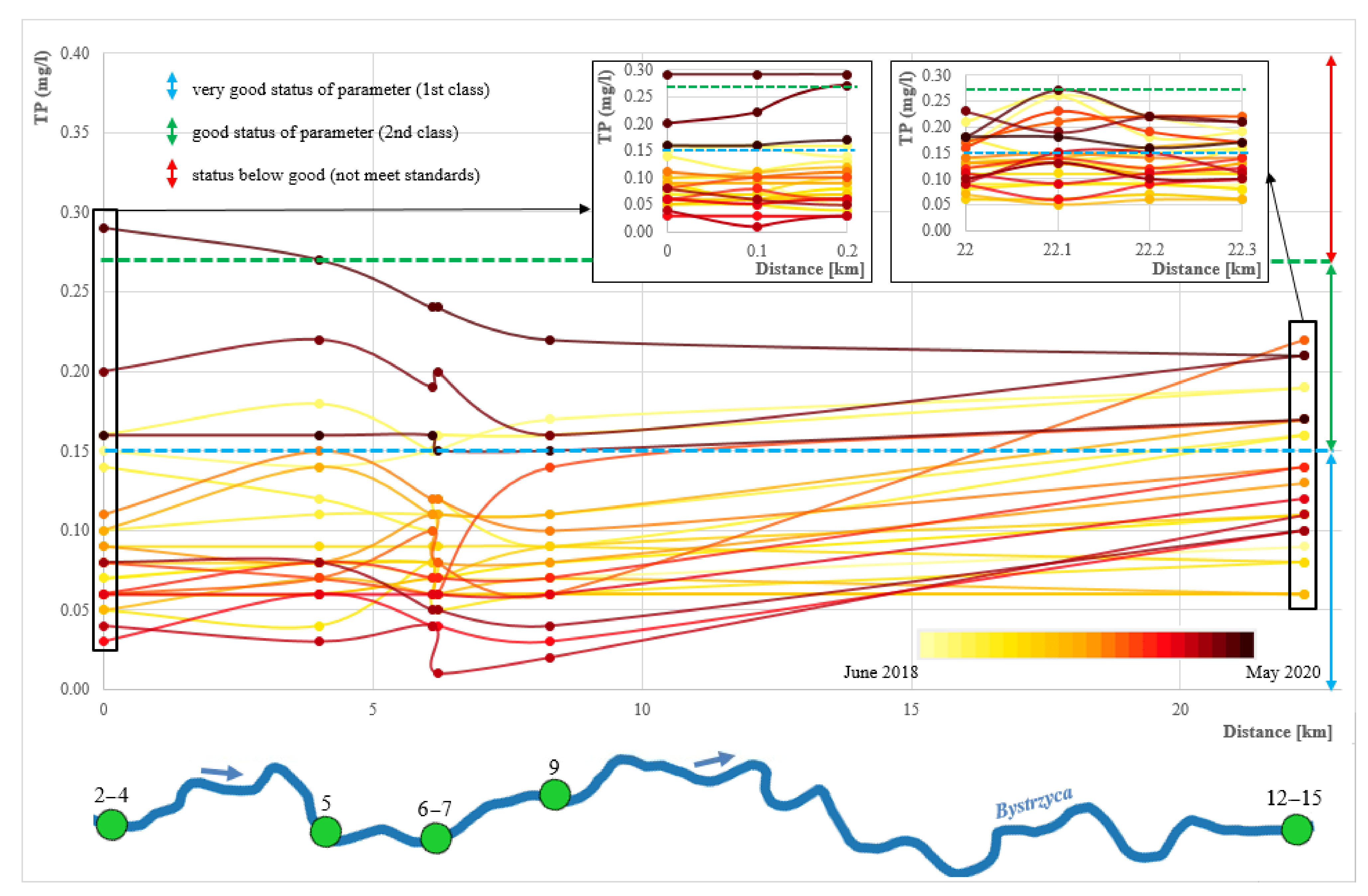
References
- REN21 (Renewable Energy Policy Network for the 21st Century). Renewables 2020: Energy Status Report 2020; REN21: Paris, France, 2021. [Google Scholar]
- Hoes, O.A.; Meijer, L.J.; Van Der Ent, R.J.; Van De Giesen, N.C. Systematic high-resolution assessment of global hydropower potential. PLoS ONE 2017, 12, e0171844. [Google Scholar] [CrossRef] [PubMed]
- Redl, C.; Hein, F.; Buck, M.; Graichen, P.; Jones, D. The European Power Sector in 2020: Up-to-Date Analysis on the Electricity Transition; Agora Energiewende, EMBER: Berlin, Germany, 2021. [Google Scholar]
- Henley, W. 2020 Hydropower Status Report: Sector Trends and Insights Report; IHA (The International Hydropower Association): London, UK, 2021. [Google Scholar]
- Tomczyk, P.; Wiatkowski, M. Challenges in the Development of Hydropower in Selected European Countries. Water 2020, 12, 3542. [Google Scholar] [CrossRef]
- Hamududu, B.H.; Killingtveit, Å. Hydropower Production in Future Climate Scenarios; the Case for the Zambezi River. Energies 2016, 9, 502. [Google Scholar] [CrossRef]
- Donk, P.; Van Uytven, E.; Willems, P.; Taylor, M.A. Assessment of the potential implications of a 1.5 °C versus higher global temperature rise for the Afobaka hydropower scheme in Suriname. Reg. Environ. Chang. 2018, 18, 2283–2295. [Google Scholar] [CrossRef]
- Bilotta, G.S.; Burnside, N.G.; Turley, M.D.; Gray, J.C.; Orr, H.G. The effects of run-of-river hydroelectric power schemes on invertebrate community composition in temperate streams and rivers. PLoS ONE 2017, 12, e0171634. [Google Scholar] [CrossRef] [PubMed]
- Kjaerstad, G.; Arnekleiv, J.V.; Speed, J.D.M.; Herland, A.K. Effects of hydropeaking on benthic invertebrate community composition in two central Norwegian rivers. River Res. Appl. 2018, 34, 218–231. [Google Scholar] [CrossRef]
- Zhou, S.; Tang, T.; Wu, N.; Fu, X.; Jiang, W.; Li, F.; Cai, Q. Impacts of cascaded small hydropower plants on microzooplankton in Xiangxi River, China. Acta Ecol. Sin. 2009, 29, 62–68. [Google Scholar] [CrossRef]
- Wiatkowski, M.; Rosik-Dulewska, C.; Tomczyk, P. Hydropower Structures in the Natura 2000 Site on the River Radew: An Analysis in the Context of Sustainable Water Development. Ann. Set Environ. Prot. 2017, 19, 65–80. [Google Scholar]
- Camargo, J.A. Responses of aquatic macrophytes to anthropogenic pressures: Comparison between macrophyte metrics and indices. Environ. Monit. Assess. 2018, 190, 173. [Google Scholar] [CrossRef]
- Virbickas, T.; Vezza, P.; Kriaučiūnienė, J. Impacts of low-head hydropower plants on cyprinid-dominated fish assemblages in Lithuanian rivers. Sci. Rep. 2020, 10, 21687. [Google Scholar] [CrossRef]
- Chiogna, G.; Majone, B.; Paoli, K.C.; Diamantini, E.; Stella, E.; Mallucci, S.; Lencioni, V.; Zandonai, F.; Bellin, A. A review of hydrological and chemical stressors in the Adige catchment and its ecological status. Sci. Total. Environ. 2016, 540, 429–443. [Google Scholar] [CrossRef]
- Bejarano, M.D.; Sordo-Ward, Á.; Alonso; Nilsson, C. Characterizing effects of hydropower plants on sub-daily flow regimes. J. Hydrol. 2017, 550, 186–200. [Google Scholar] [CrossRef]
- Młyński, D.; Operacz, A.; Wałęga, A. Sensitivity of methods for calculating environmental flows based on hydrological characteristics of watercourses regarding the hydropower potential of rivers. J. Clean. Prod. 2020, 250, 119527. [Google Scholar] [CrossRef]
- Nguyen, T.H.T.; Forio, M.A.E.; Boets, P.; Lock, K.; Ambarita, M.N.D.; Suhareva, N.; Everaert, G.; Van Der Heyden, C.; Dominguez-Granda, L.E.; Hoang, T.H.T.; et al. Threshold Responses of Macroinvertebrate Communities to Stream Velocity in Relation to Hydropower Dam: A Case Study from The Guayas River Basin (Ecuador). Water 2018, 10, 1195. [Google Scholar] [CrossRef]
- Kibler, K.M.; Tullos, D.D. Cumulative biophysical impact of small and large hydropower development in Nu River, China. Water Resour. Res. 2013, 49, 3104–3118. [Google Scholar] [CrossRef]
- Kumar, A.; Sharma, M. Greenhouse Gas Emissions from Hydropower Reservoirs. Hydro Nepal J. Water Energy Environ. 2012, 11, 37–42. [Google Scholar] [CrossRef]
- Soininen, N.; Belinskij, A.; Vainikka, A.; Huuskonen, H. Bringing back ecological flows: Migratory fish, hydropower and legal maladaptivity in the governance of Finnish rivers. Water Int. 2018, 44, 321–336. [Google Scholar] [CrossRef]
- Klaver, G.; Van Os, B.; Negrel, P.; Petelet-Giraud, E. Influence of hydropower dams on the composition of the suspended and riverbank sediments in the Danube. Environ. Pollut. 2007, 148, 718–728. [Google Scholar] [CrossRef]
- Del Tánago, M.G.; Gurnell, A.M.; Belletti, B.; De Jalón, D.G. Indicators of river system hydromorphological character and dynamics: Understanding current conditions and guiding sustainable river management. Aquat. Sci. 2016, 78, 35–55. [Google Scholar] [CrossRef]
- Anderson, D.; Moggridge, H.; Warren, P.; Shucksmith, J. The impacts of ‘run-of-river’ hydropower on the physical and ecological condition of rivers. Water Environ. J. 2015, 29, 268–276. [Google Scholar] [CrossRef]
- Warner, R.F. Environmental impacts of hydroelectric power and other anthropogenic developments on the hydromorphology and ecology of the Durance channel and the Etang de Berre, southeast France. J. Environ. Manag. 2012, 104, 35–50. [Google Scholar] [CrossRef]
- Bishwakarma, M.; Støle, H. Real-time sediment monitoring in hydropower plants. J. Hydraul. Res. 2008, 46, 282–288. [Google Scholar] [CrossRef]
- Wiatkowski, M.; Tomczyk, P. Comparative Assessment of the Hydromorphological Status of the Rivers Odra, Bystrzyca, and Ślęza Using the RHS, LAWA, QBR, and HEM Methods above and below the Hydropower Plants. Water 2018, 10, 855. [Google Scholar] [CrossRef]
- Bakken, T.H.; Sundt, H.; Ruud, A.; Harby, A. Development of Small Versus Large Hydropower in Norway—Comparison of Environmental Impacts. Energy Procedia 2012, 20, 185–199. [Google Scholar] [CrossRef]
- Bunea, F.; Ciocan, G.D.; Oprina, G.; Baran, G.; Babutanu, C.A. Hydropower Impact on Water Quality. Environ. Eng. Manag. J. 2010, 9, 1459–1464. [Google Scholar] [CrossRef]
- Siergieiev, D.; Widerlund, A.; Lundberg, A.; Almqvist, L.; Collomp, M.; Ingri, J.; Öhlander, B. Impact of Hydropower Regulation on River Water Composition in Northern Sweden. Aquat. Geochem. 2013, 20, 59–80. [Google Scholar] [CrossRef]
- Tomczyk, P.; Wiatkowski, M. Shaping changes in the ecological status of watercourses within barrages with hydropower schemes—Literature review. Arch. Environ. Prot. 2020, 46, 78–94. [Google Scholar] [CrossRef]
- Kelly-Richards, S.; Silber-Coats, N.; Crootof, A.; Tecklin, D.; Bauer, C. Governing the transition to renewable energy: A review of impacts and policy issues in the small hydropower boom. Energy Policy 2017, 101, 251–264. [Google Scholar] [CrossRef]
- Rodriguez, J.-F. Hydropower landscapes and tourism development in the Pyrenees. Revue Géographie Alpine 2012, 100. [Google Scholar] [CrossRef]
- Ezcurra, E.; Barrios, E.; Ezcurra, P.; Ezcurra, A.; Vanderplank, S.; Vidal, O.; Villanueva-Almanza, L.; Aburto-Oropeza, O. A natural experiment reveals the impact of hydroelectric dams on the estuaries of tropical rivers. Sci. Adv. 2019, 5, eaau9875. [Google Scholar] [CrossRef] [PubMed]
- Spänhoff, B. Current status and future prospects of hydropower in Saxony (Germany) compared to trends in Germany, the European Union and the World. Renew. Sustain. Energy Rev. 2014, 30, 518–525. [Google Scholar] [CrossRef]
- Igliński, B. Hydro energy in Poland: The history, current state, potential, SWOT analysis, environmental aspects. Int. J. Energy Water Resour. 2019, 3, 61–72. [Google Scholar] [CrossRef]
- Wei, G.; Yang, Z.; Cui, B.; Li, B.; Chen, H.; Bai, J.; Dong, S. Impact of Dam Construction on Water Quality and Water Self-Purification Capacity of the Lancang River, China. Water Resour. Manag. 2009, 23, 1763–1780. [Google Scholar] [CrossRef]
- Yu, B.; Xu, L. Review of ecological compensation in hydropower development. Renew. Sustain. Energy Rev. 2016, 55, 729–738. [Google Scholar] [CrossRef]
- Fjeldstad, H.-P.; Pulg, U.; Forseth, T. Safe two-way migration for salmonids and eel past hydropower structures in Europe: A review and recommendations for best-practice solutions. Mar. Freshw. Res. 2018, 69, 1834–1847. [Google Scholar] [CrossRef]
- Schilt, C.R. Developing fish passage and protection at hydropower dams. Appl. Anim. Behav. Sci. 2007, 104, 295–325. [Google Scholar] [CrossRef]
- Kuriqi, A.; Pinheiro, A.N.; Sordo-Ward, A.; Bejarano, M.D.; Garrote, L. Ecological impacts of run-of-river hydropower plants—Current status and future prospects on the brink of energy transition. Renew. Sustain. Energy Rev. 2021, 142, 110833. [Google Scholar] [CrossRef]
- Suwal, N.; Kuriqi, A.; Huang, X.; Delgado, J.; Młyński, D.; Walega, A. Environmental Flows Assessment in Nepal: The Case of Kaligandaki River. Sustainability 2020, 12, 8766. [Google Scholar] [CrossRef]
- Okuku, E.O.; Bouillon, S.; Ochiewo, J.O.; Munyi, F.; Kiteresi, L.I.; Tole, M. The impacts of hydropower development on rural livelihood sustenance. Int. J. Water Resour. Dev. 2015, 32, 267–285. [Google Scholar] [CrossRef]
- Bejarano, M.; Sordo-Ward, A.; Gabriel-Martin, I.; Garrote, L. Tradeoff between economic and environmental costs and benefits of hydropower production at run-of-river-diversion schemes under different environmental flows scenarios. J. Hydrol. 2019, 572, 790–804. [Google Scholar] [CrossRef]
- Schramm, M.P.; Bevelhimer, M.S.; DeRolph, C.R. A synthesis of environmental and recreational mitigation requirements at hydropower projects in the United States. Environ. Sci. Policy 2016, 61, 87–96. [Google Scholar] [CrossRef]
- Mensah, J. Sustainable development: Meaning, history, principles, pillars, and implications for human action: Literature review. Cogent Soc. Sci. 2019, 5. [Google Scholar] [CrossRef]
- Chala, G.T.; Ma’Arof, M.I.N.; Sharma, R. Trends in an increased dependence towards hydropower energy utilization—a short review. Cogent Eng. 2019, 6. [Google Scholar] [CrossRef]
- Česonienė, L.; Dapkienė, M.; Punys, P. Assessment of the Impact of Small Hydropower Plants on the Ecological Status Indicators of Water Bodies: A Case Study in Lithuania. Water 2021, 13, 433. [Google Scholar] [CrossRef]
- Vaikasas, S.; Bastienė, N.; Pliūraitė, V. Impact of small hydropower plants on physicochemical and biotic environments in flatland riverbeds in Lithuania. J. Water Secur. 2015, 1, 1–13. [Google Scholar] [CrossRef]
- Foley, M.M.; Duda, J.J.; Beirne, M.M.; Paradis, R.; Ritchie, A.; Warrick, J.A. Rapid water quality change in the Elwha River estuary complex during dam removal. Limnol. Oceanogr. 2015, 60, 1719–1732. [Google Scholar] [CrossRef]
- Ashby, S.L.; Myers, J.L.; Laney, E.; Honnell, D.; Owens, C. The Effects of Hydropower Releases from Lake Texoma on Downstream Water Quality. J. Freshw. Ecol. 1999, 14, 103–112. [Google Scholar] [CrossRef]
- Bouaroudj, S.; Menad, A.; Bounamous, A.; Ali-Khodja, H.; Gherib, A.; Weigel, D.E.; Chenchouni, H. Assessment of water quality at the largest dam in Algeria (Beni Haroun Dam) and effects of irrigation on soil characteristics of agricultural lands. Chemosphere 2019, 219, 76–88. [Google Scholar] [CrossRef]
- Hudson-Edwards, K.A.; Macklin, M.G.; Jamieson, H.E.; Brewer, P.A.; Coulthard, T.J.; Howard, A.J.; Turner, J.N. The impact of tailings dam spills and clean-up operations on sediment and water quality in river systems: The Ríos Agrio–Guadiamar, Aznalcóllar, Spain. Appl. Geochem. 2003, 18, 221–239. [Google Scholar] [CrossRef]
- Zhang, Y.; Xia, J.; Liang, T.; Shao, Q. Impact of Water Projects on River Flow Regimes and Water Quality in Huai River Basin. Water Resour. Manag. 2010, 24, 889–908. [Google Scholar] [CrossRef]
- Muhammetoglu, A.; Muhammetoglu, H.; Oktas, S.; Ozgokcen, L.; Soyupak, S. Impact Assessment of Different Management Scenarios on Water Quality of Porsuk River and Dam System—Turkey. Water Resour. Manag. 2005, 19, 199–210. [Google Scholar] [CrossRef]
- Brainwood, M.; Burgin, S.; Maheshwari, B. Temporal variations in water quality of farm dams: Impacts of land use and water sources. Agric. Water Manag. 2004, 70, 151–175. [Google Scholar] [CrossRef]
- Valero, E. Characterization of the Water Quality Status on a Stretch of River Lérez around a Small Hydroelectric Power Station. Water 2012, 4, 815–834. [Google Scholar] [CrossRef]
- Álvarez, X.; Valero, E.; De La Torre-Rodríguez, N.; Acuña-Alonso, C. Influence of Small Hydroelectric Power Stations on River Water Quality. Water 2020, 12, 312. [Google Scholar] [CrossRef]
- Fantin-Cruz, I.; Pedrollo, O.C.; Girard, P.; Zeilhofer, P.; Hamilton, S.K. Changes in river water quality caused by a diversion hydropower dam bordering the Pantanal floodplain. Hydrobiology 2015, 768, 223–238. [Google Scholar] [CrossRef]
- Winton, R.S.; Calamita, E.; Wehrli, B. Reviews and syntheses: Dams, water quality and tropical reservoir stratification. Biogeosciences 2019, 16, 1657–1671. [Google Scholar] [CrossRef]
- Wu, J.-H.; Zhou, Y.; Ma, F. Air entrainment of hydraulic jump aeration basin. J. Hydrodyn. 2018, 30, 962–965. [Google Scholar] [CrossRef]
- Fantin-Cruz, I.; Pedrollo, O.; Girard, P.; Zeilhofer, P.; Hamilton, S.K. Effects of a diversion hydropower facility on the hydrological regime of the Correntes River, a tributary to the Pantanal floodplain, Brazil. J. Hydrol. 2015, 531, 810–820. [Google Scholar] [CrossRef]
- Lewis, W.M. Basis for the protection and management of tropical lakes. Lakes Reserv. Res. Manag. 2000, 5, 35–48. [Google Scholar] [CrossRef]
- Preece, R.M.; Jones, H.A. The effect of Keepit Dam on the temperature regime of the Namoi River, Australia. River Res. Appl. 2002, 18, 397–414. [Google Scholar] [CrossRef]
- Magadza, C.H.D. Environmental state of Lake Kariba and Zambezi River Valley: Lessons learned and not learned. Lakes Reserv. Res. Manag. 2010, 15, 167–192. [Google Scholar] [CrossRef]
- Pimenta, A.M.; Albertoni, E.F.; Palma-Silva, C. Characterization of water quality in a small hydropower plant reservoir in southern Brazil. Lakes Reserv. Res. Manag. 2012, 17, 243–251. [Google Scholar] [CrossRef]
- Da Cruz, R.F.; Hamilton, S.K.; Tritico, H.M.; Fantin-Cruz, I.; de Figueiredo, D.M.; Zeilhofer, P. Water quality impacts of small hydroelectric power plants in a tributary to the Pantanal floodplain, Brazil. River Res. Appl. 2021, 37, 448–461. [Google Scholar] [CrossRef]
- Lobato, T.D.C.; Hauser-Davis, R.A.; De Oliveira, T.F.; Maciel, M.C.; Tavares, M.R.M.; Da Silveira, A.M.; Saraiva, A.C.F. Categorization of the trophic status of a hydroelectric power plant reservoir in the Brazilian Amazon by statistical analyses and fuzzy approaches. Sci. Total. Environ. 2015, 506–507, 613–620. [Google Scholar] [CrossRef]
- Olden, J.D.; Naiman, R.J. Incorporating thermal regimes into environmental flows assessments: Modifying dam operations to restore freshwater ecosystem integrity. Freshw. Biol. 2010, 55, 86–107. [Google Scholar] [CrossRef]
- Zhong, Y.; Power, G. Environmental impacts of hydroelectric projects o n fish resources. Regul. Rivers Res. Manag. 2015, 12, 81–98. [Google Scholar] [CrossRef]
- Bogen, J.; Bønsnes, T.E. The impact of a hydroelectric power plant on the sediment load in downstream water bodies, Svartisen, northern Norway. Sci. Total. Environ. 2001, 266, 273–280. [Google Scholar] [CrossRef]
- Maavara, T.; Parsons, C.T.; Ridenour, C.; Stojanovic, S.; Dürr, H.H.; Powley, H.R.; Van Cappellen, P. Global phosphorus retention by river damming. Proc. Natl. Acad. Sci. USA 2015, 112, 15603–15608. [Google Scholar] [CrossRef]
- Smith, V.; Tilman, G.; Nekola, J. Eutrophication: Impacts of excess nutrient inputs on freshwater, marine, and terrestrial ecosystems. Environ. Pollut. 1999, 100, 179–196. [Google Scholar] [CrossRef]
- Vowles, A.S.; Karlsson, S.P.; Uzunova, E.P.; Kemp, P.S. The importance of behaviour in predicting the impact of a novel small-scale hydropower device on the survival of downstream moving fish. Ecol. Eng. 2014, 69, 151–159. [Google Scholar] [CrossRef]
- Xue, S.; Wang, Y.; Li, K.; Li, R. Wang Effects of Total Dissolved Gas Supersaturation in Fish of Different Sizes and Species. Int. J. Environ. Res. Public Health 2019, 16, 2444. [Google Scholar] [CrossRef] [PubMed]
- Brown, R.S.; Colotelo, A.H.; Pflugrath, B.D.; Boys, C.A.; Baumgartner, L.J.; Deng, Z.D.; Silva, L.G.M.; Brauner, C.J.; Mallen-Cooper, M.; Phonekhampeng, O.; et al. Understanding Barotrauma in Fish Passing Hydro Structures: A Global Strategy for Sustainable Development of Water Resources. Fisheries 2014, 39, 108–122. [Google Scholar] [CrossRef]
- Ma, Q.; Li, R.; Feng, J.; Lu, J.; Zhou, Q. Cumulative effects of cascade hydropower stations on total dissolved gas supersaturation. Environ. Sci. Pollut. Res. 2018, 25, 13536–13547. [Google Scholar] [CrossRef] [PubMed]
- Geoportal (Topographic Map, Map of Protected Areas, Hydrographic Map). Available online: https://mapy.geoportal.gov.pl/imap/Imgp_2.html (accessed on 10 February 2021).
- Grzywna, A.; Bronowicka-Mielniczuk, U. Spatial and Temporal Variability of Water Quality in the Bystrzyca River Basin, Poland. Water 2020, 12, 190. [Google Scholar] [CrossRef]
- The European Parliament and the Council. Directive 2000/60/EC of the European Parliament and of the Council Establishing a Framework for Community Action in the Field of Water Policy; The European Parliament and the Council: Brussels, Belgium, 2000. [Google Scholar]
- Arle, J.; Mohaupt, V.; Kirst, I. Monitoring of Surface Waters in Germany under the Water Framework Directive—A Review of Approaches, Methods and Results. Water 2016, 8, 217. [Google Scholar] [CrossRef]
- WIOŚ/OBKŚ (Regional Inspectorate for Environmental Protection/Environmental Research and Control Center), Water Quality Report in the Dolnośląskie/Wrocławskie Voivodeship (Measurement Points: Kamionna, Jarnołtów, Samotwór, Leśnica and Janówek on the Bystrzyca River), Wrocław 1970–1989, 1992–2008, 2012, 2013, 2015, 2018, Poland (technical reports).
- RZGW (The State Water Holding “Polish Waters”—Regional Water Management Authority). List of Hydropower Plants in the Area of RZGW Wrocław’s Operation; Regional Water Management Authority: Wrocław, Poland, 2020. [Google Scholar]
- Minister of Maritime Economy and Inland Navigation. Regulation of the Minister of Maritime Economy and Inland Navigation of 11 October 2019 on the Classification of Ecological Status, Ecological Potential and Chemical Status and the Method of Classifying the Status of Surface Water Bodies as Well as Environmental Quality Standards for Priority Substances; OJ 2019 item 2149; Prime Minister of Poland: Warsaw, Poland, 2019. (In Polish) [Google Scholar]
- Wdowczyk, A.; Szymańska-Pulikowska, A. Differences in the Composition of Leachate from Active and Non-Operational Municipal Waste Landfills in Poland. Water 2020, 12, 3129. [Google Scholar] [CrossRef]
- Minister of the Environment (in Poland). Regulation of the Minister of the Environment of October 4, 2002 on the Requirements to Be Met by Inland Waters That Are the Environment for Fish Living in Natural Conditions; Minister of the Environment: Warsaw, Poland, 2002. (In Polish) [Google Scholar]
- Lloyd, R. Pollution and Freshwater Fish, 1st ed.; Fishing News Books Ltd.: London, UK, 1992. [Google Scholar]
- Bergheim, A.; Selmer-Olsen, A.R. River pollution from a large trout farm in Norway. Aquaculture 1978, 14, 267–270. [Google Scholar] [CrossRef]
- Roberts, R.J.; Shepherd, C.J. Handbook of Trout and Salmon Diseases, 1st ed.; Fishing News: London, UK, 1974. [Google Scholar]
- Stiff, M.J.; Cartwright, N.G.; Crane, R.I. Environmental Quality Standards for Dissolved Oxygen, 1st ed.; National Rivers Authority: Bristol, UK, 1992. [Google Scholar]
- Chapman, G. Ambient Water Quality Criteria for Dissolved Oxygen, 1st ed.; U.S. Environmental Protection Agency (USEPA): Duluth, MN, USA; Narrangansett, RI, USA, 1986. [Google Scholar]
- JRB Associated. Analysis of Data Relating Dissolved Oxygen and Fish Growth; JRB Associated: Newport News, VA, USA, 1984. [Google Scholar]
- EIFAC (European Inland Fisheries Advisory Commision). Water Quality Criteria for European Freshwater Fish; FAO: Rome, Italy, 1987. [Google Scholar]
- Beamish, F. Respiration of fishes with special emphasis on standard oxygen consumption: III. Influence of oxygen. Canadian J. Zool. 2011, 42, 355–366. [Google Scholar] [CrossRef]
- Coble, W.C. Fish Populations in Relation to Dissolved Oxygen in the Wisconsin River. Trans. Am. Fish. Soc. 1982, 111, 612–623. [Google Scholar] [CrossRef]
- Lawson, T.B. Fundamentals of Aquacultural Engineering, 1st ed.; Springer: Boston, MA, USA, 1995. [Google Scholar] [CrossRef]
- Homer, D.H.; Waller, W.T. Chronic effects of reduced dissolved oxygen on Daphnia magna. Water Air Soil Pollut. 1983, 20, 23–28. [Google Scholar] [CrossRef]
- Spoor, W.A. Distribution of fingerling brook trout, Salvelinus fontinalis (Mitchill), in dissolved oxygen concentration gradients. J. Fish Biol. 1990, 36, 363–373. [Google Scholar] [CrossRef]
- Glińska-Lewczuk, K.; Gołaś, I.; Koc, J.; Gotkowska-Płachta, A.; Harnisz, M.; Rochwerger, A. The impact of urban areas on the water quality gradient along a lowland river. Environ. Monit. Assess. 2016, 188, 624. [Google Scholar] [CrossRef]
- Zbierska, J.; Ławniczak, A.E.; Zbierska, A. Changes in the trophic status of Lake Niepruszewskie (Poland). J. Ecol. Eng. 2015, 16, 65–73. [Google Scholar] [CrossRef][Green Version]
- Speers-Roesch, B.; Norin, T. Ecological significance of thermal tolerance and performance in fishes: New insights from integrating field and laboratory approaches. Funct. Ecol. 2016, 30, 842–844. [Google Scholar] [CrossRef]
- Puzdrowska, M.; Heese, T. Experimental Studies on the Spatial Structure and Distribution of Flow Velocities in Bolt Fishways. J. Ecol. Eng. 2019, 20, 82–99. [Google Scholar] [CrossRef]
- Mueller, M.; Pander, J.; Geist, J. Evaluation of external fish injury caused by hydropower plants based on a novel field-based protocol. Fish. Manag. Ecol. 2017, 24, 240–255. [Google Scholar] [CrossRef]
- Kougias, I.; Aggidis, G.; Avellan, F.; Deniz, S.; Lundin, U.; Moro, A.; Muntean, S.; Novara, D.; Pérez-Díaz, J.I.; Quaranta, E.; et al. Analysis of emerging technologies in the hydropower sector. Renew. Sustain. Energy Rev. 2019, 113, 109257. [Google Scholar] [CrossRef]
- Operacz, A.; Wałęga, A.; Cupak, A.; Tomaszewska, B. The comparison of environmental flow assessment—The barrier for investment in Poland or river protection? J. Clean. Prod. 2018, 193, 575–592. [Google Scholar] [CrossRef]
- Benoit, K.; Hayden, J. Institutional Change and Persistence: The Evolution of Poland’s Electoral System, 1989–2001. J. Politi. 2004, 66, 396–427. [Google Scholar] [CrossRef]
- Gomułka, S. Poland’s economic and social transformation 1989–2014 and contemporary challenges. Central Bank Rev. 2016, 16, 19–23. [Google Scholar] [CrossRef]
- Millard, F. Environmental policy in Poland. Environ. Polit. 1998, 7, 145–161. [Google Scholar] [CrossRef]
- Bartniczak, B.; Raszkowski, A. Sustainable forest management in Poland. Manag. Environ. Qual. Int. J. 2018, 29, 666–677. [Google Scholar] [CrossRef]
- Niedziałkowski, K.; Paavola, J.; Jędrzejewska, B. Governance of biodiversity in Poland before and after the accession to the EU: The tale of two roads. Environ. Conserv. 2012, 40, 108–118. [Google Scholar] [CrossRef]
- Kobus, P.; Wąs, A. Changes in Polish Farmers’ Attitudes toward Risk after Poland’s Accession to the EU. J. Food Prod. Mark. 2016, 23, 1–10. [Google Scholar] [CrossRef]
- Chancellery of the Sejm in Poland. Act of 20 July 2017—Water Law. J. Laws 2017, 2017, 1556. [Google Scholar]
- Szoszkiewicz, K.; Jusik, S.; Pietruczuk, K.; Gebler, D. The Macrophyte Index for Rivers (MIR) as an Advantageous Approach to Running Water Assessment in Local Geographical Conditions. Water 2019, 12, 108. [Google Scholar] [CrossRef]
- European Commission. 2020 Climate & Energy Package; European Commission: Brussels, Belgium, 2007; Available online: https://ec.europa.eu/clima/policies/strategies/2020_en (accessed on 29 January 2020).
- European Parliament and the Council. Directive 2009/28/EC of the European Parliament and of the Council of 23 April 2009 on the Promotion of the Use of Energy from Renewable Sources and Amending and Subsequently Repealing Directives 2001/77/EC and 2003/30/EC.; European Parliament and the Council: Brussels, Belgium, 2009. [Google Scholar]
- Huđek, H.; Žganec, K.; Pusch, M.T. A review of hydropower dams in Southeast Europe—Distribution, trends and availability of monitoring data using the example of a multinational Danube catchment subarea. Renew. Sustain. Energy Rev. 2020, 117, 109434. [Google Scholar] [CrossRef]
- Ministry of Economy. Energy Policy of Poland Until 2030; Annex to the Resolution No. 202/2009 of the Council of Ministers of 10 November 2009; Ministry of Economy: Warsaw, Poland, 2009. [Google Scholar]
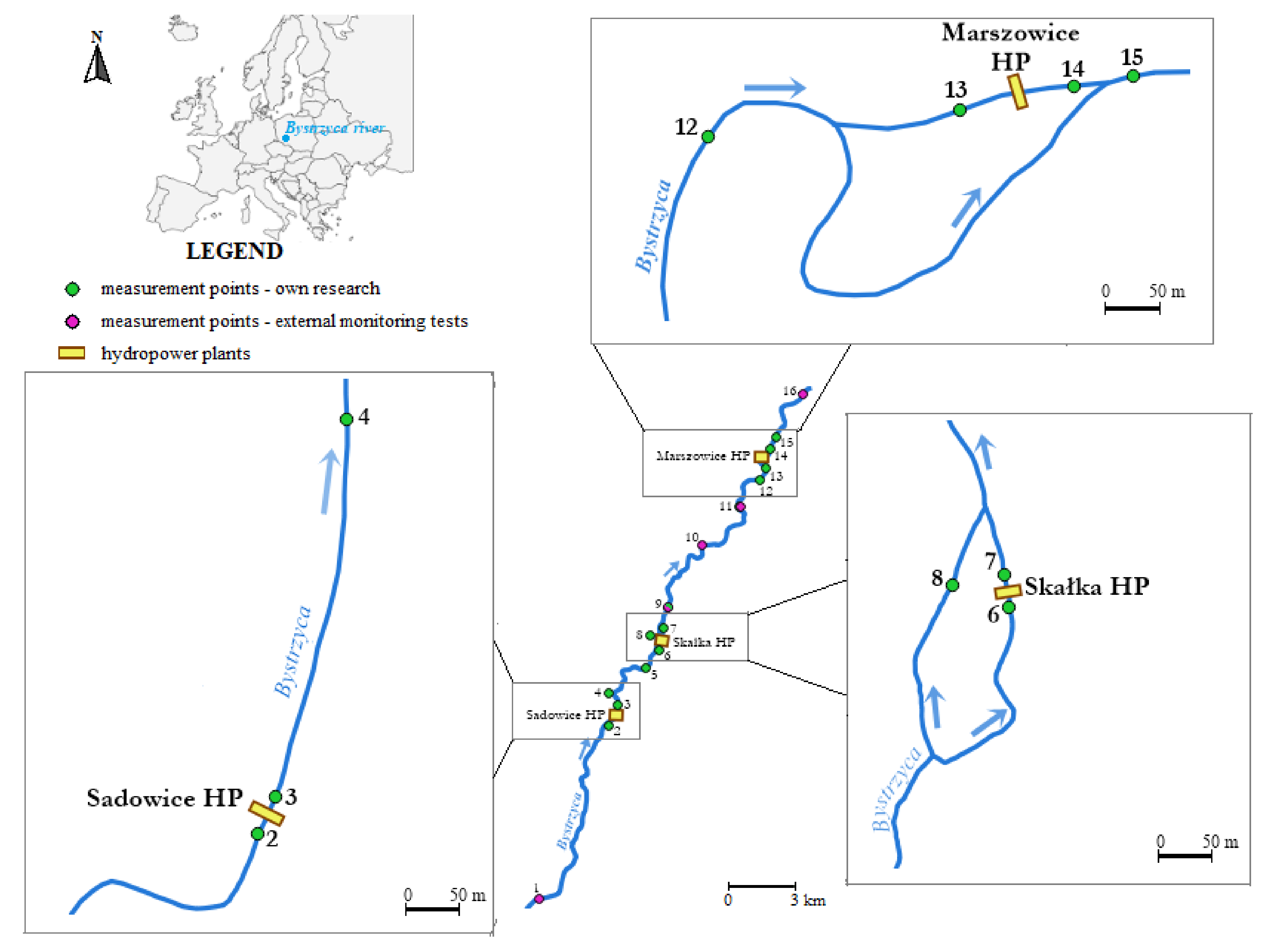

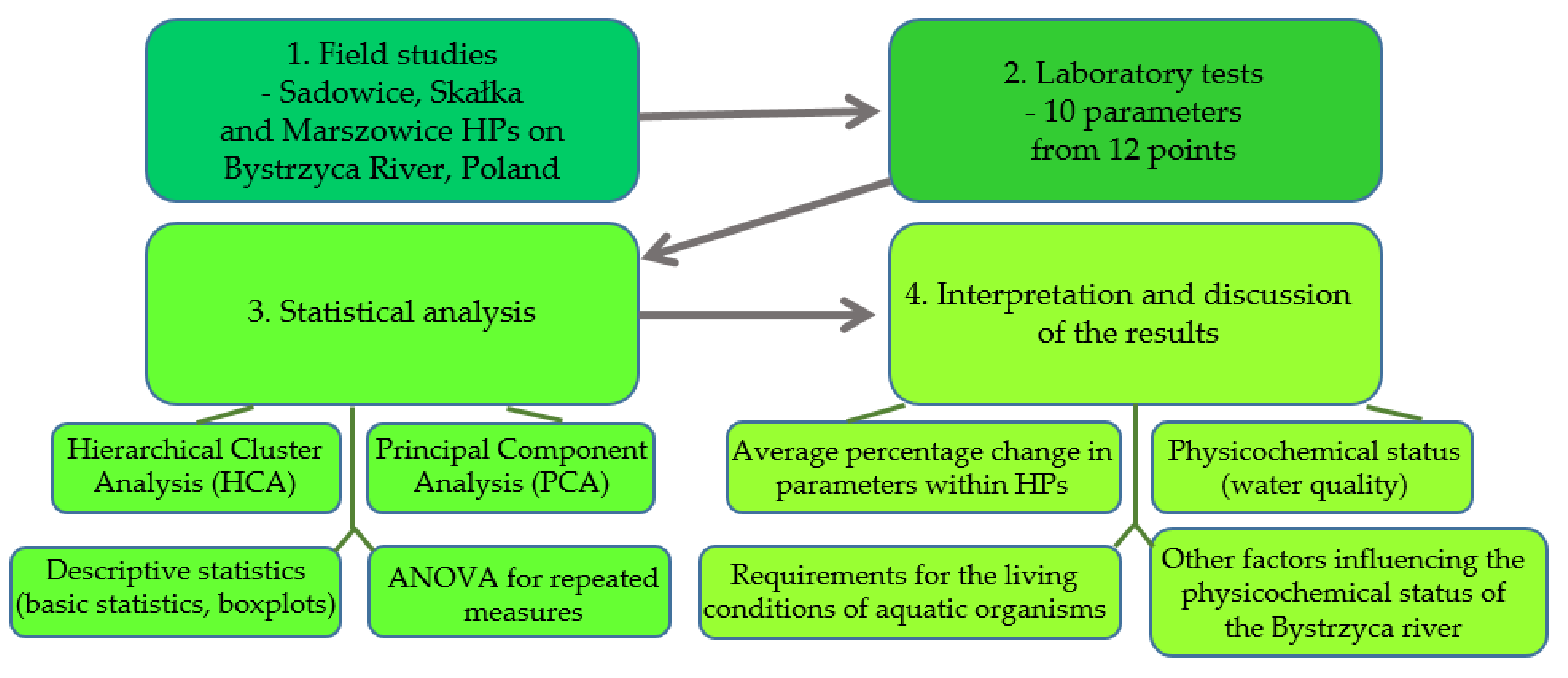
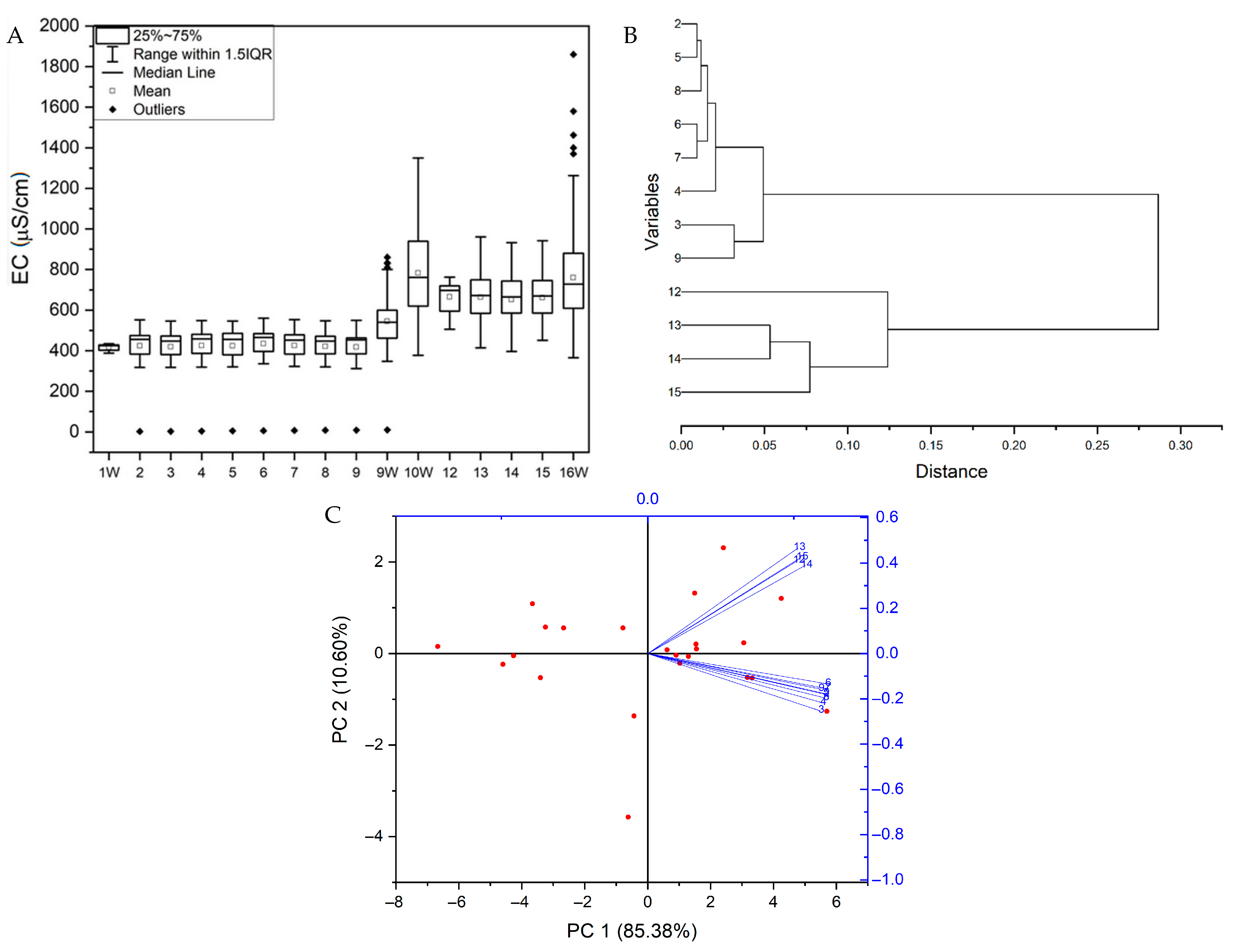
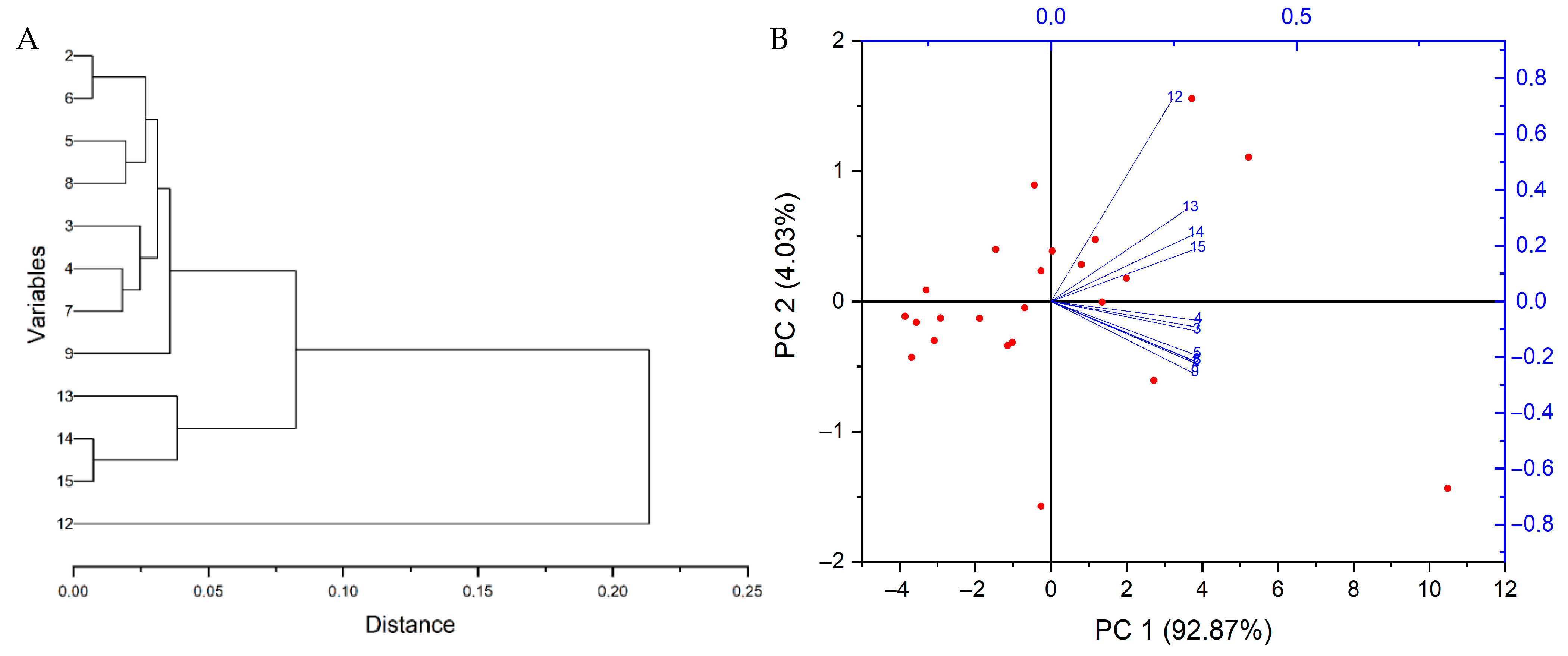
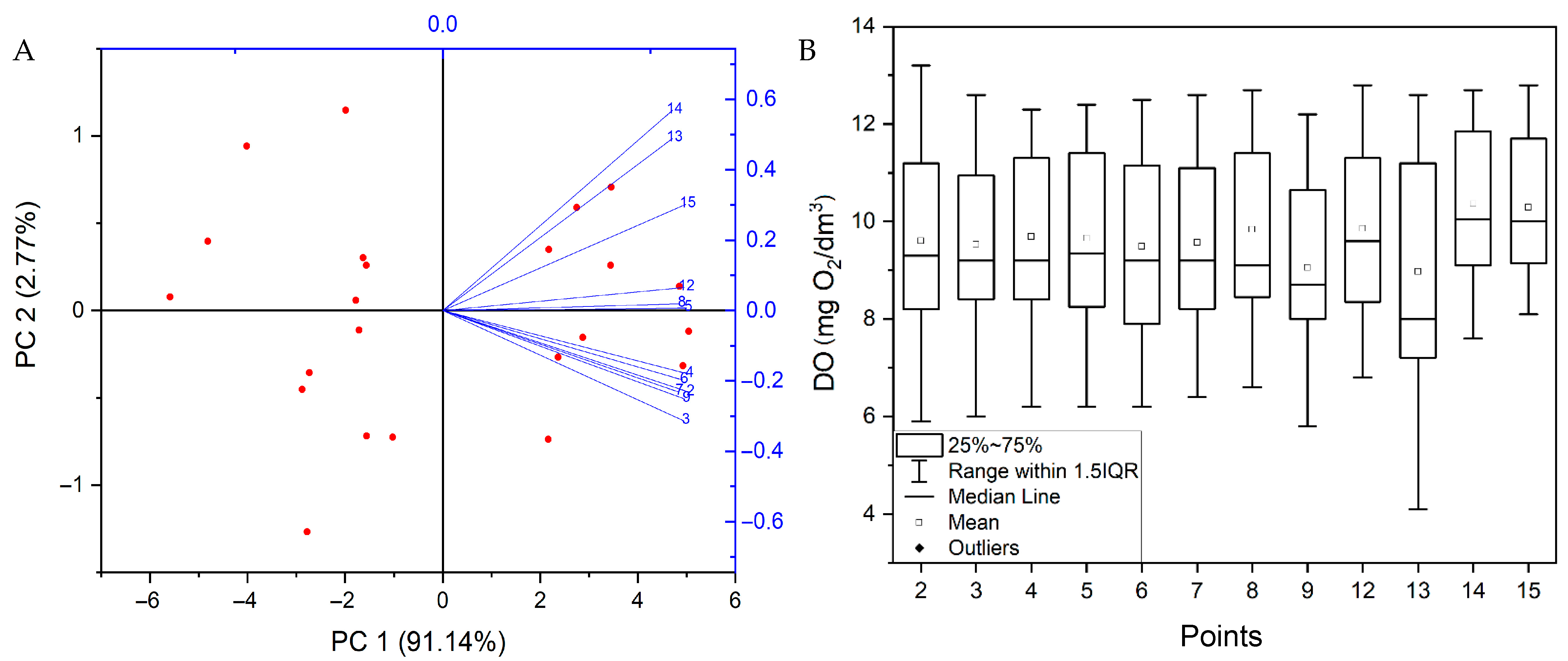
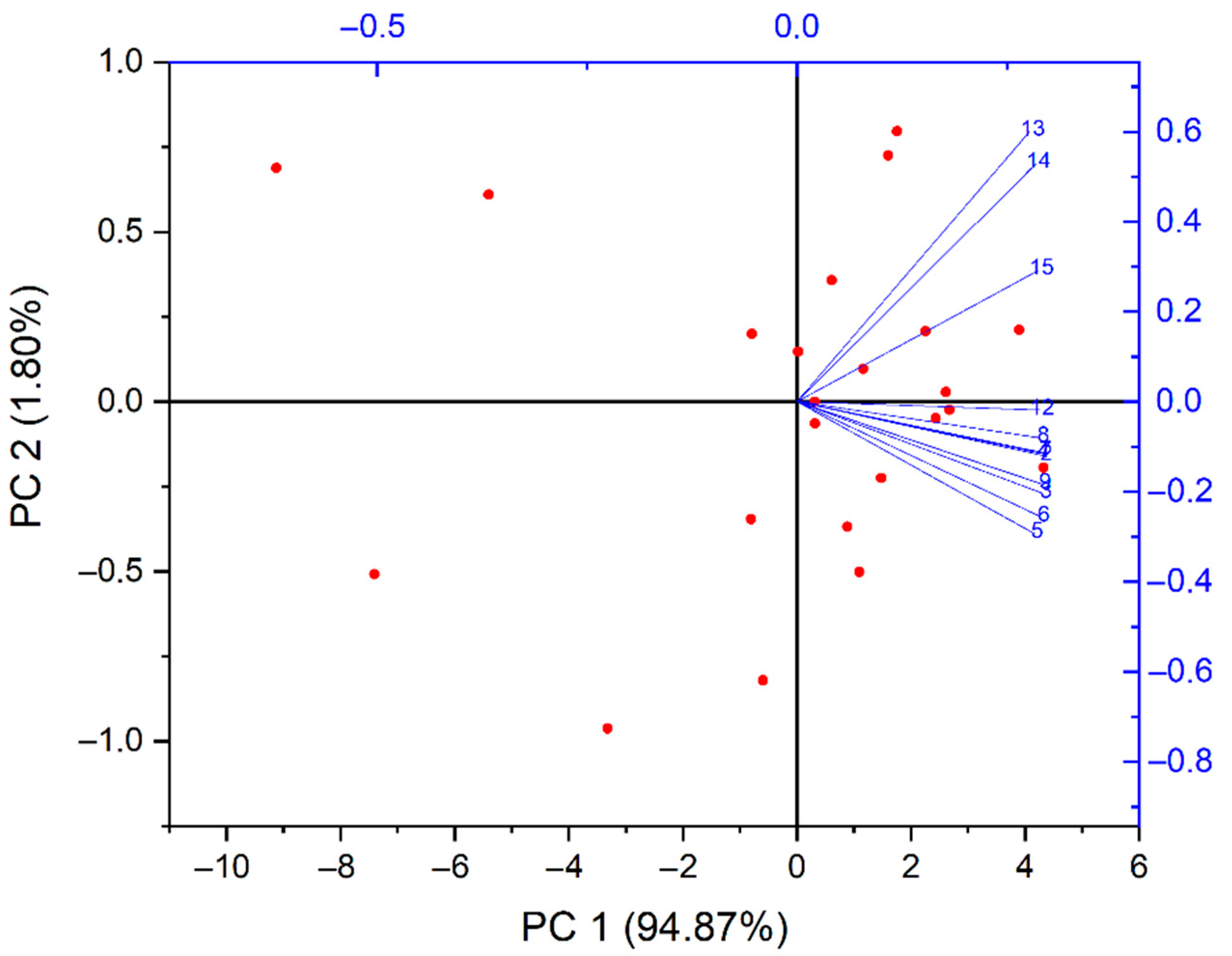
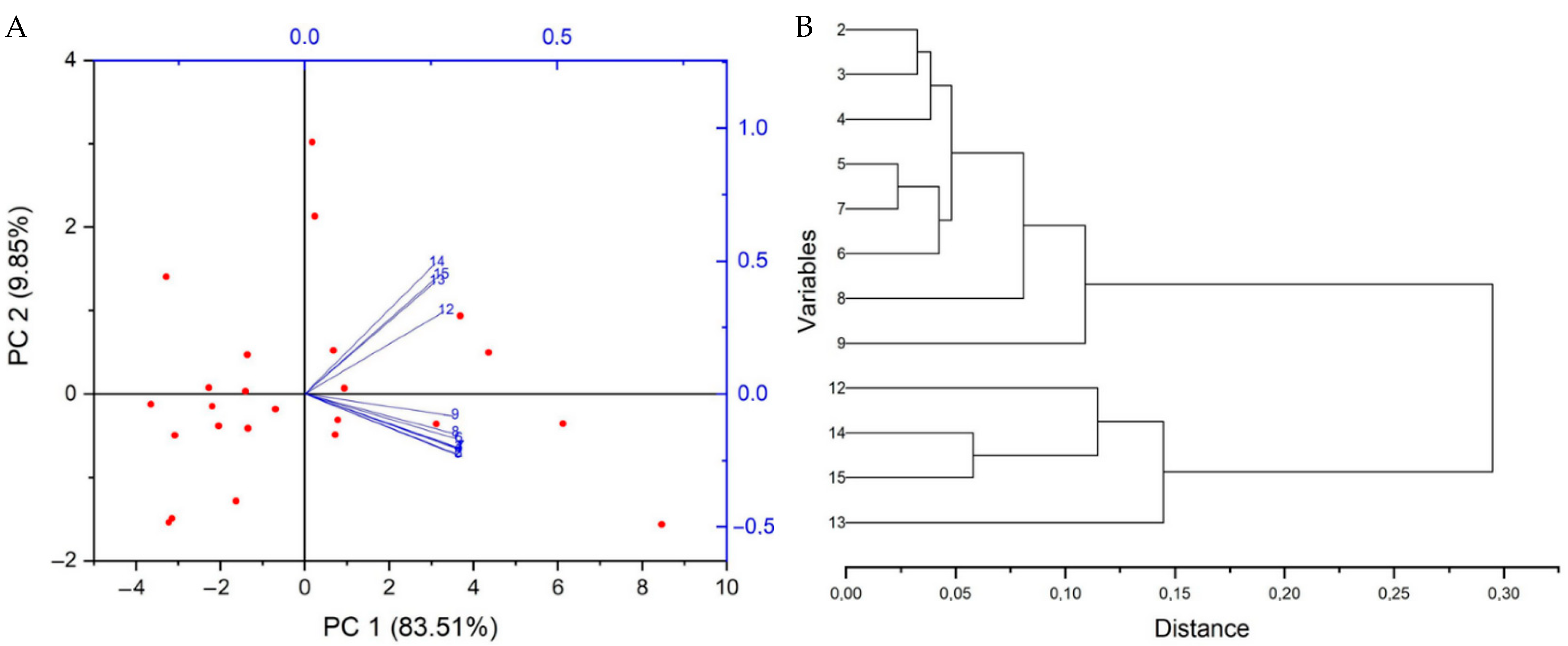
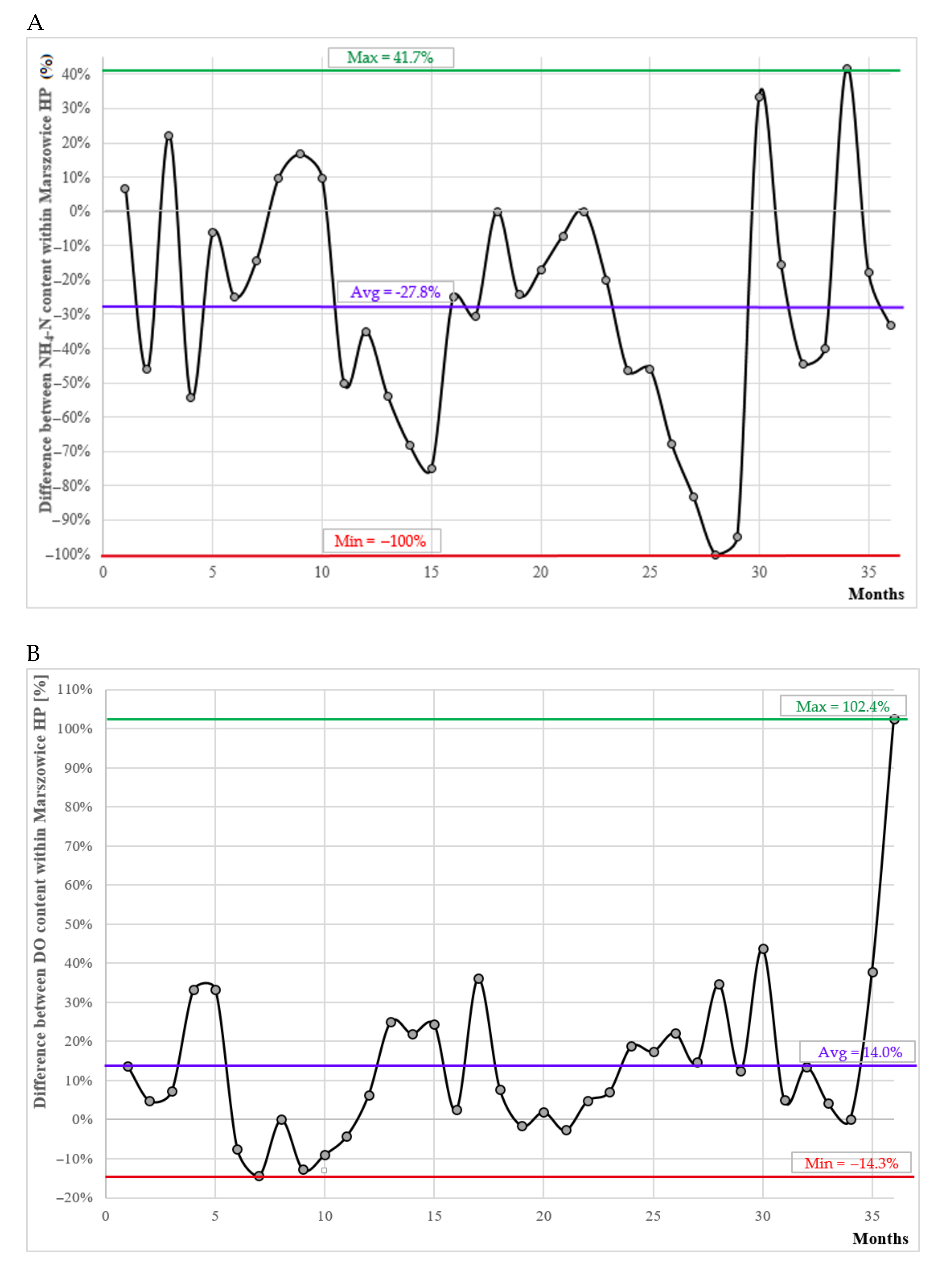
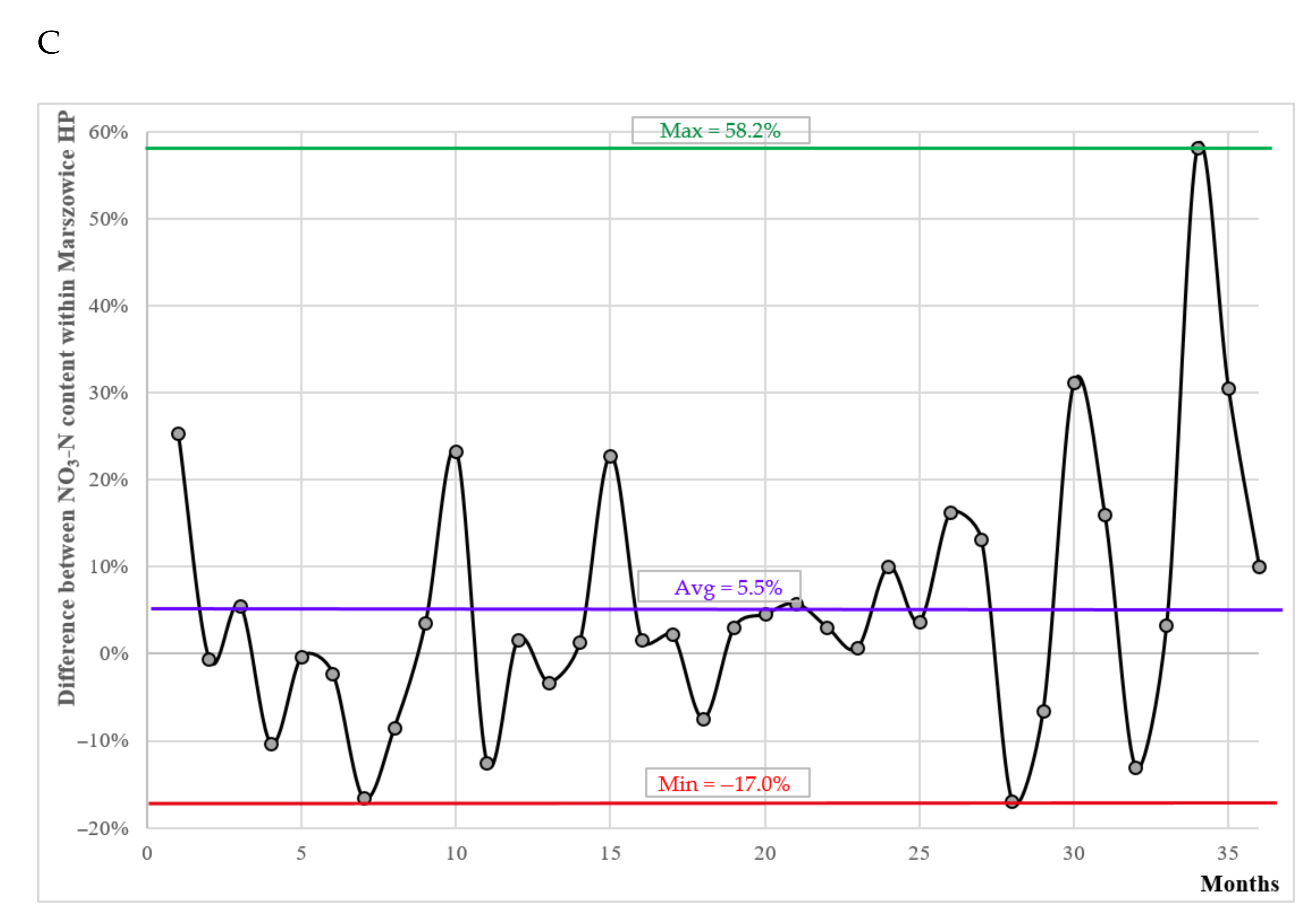
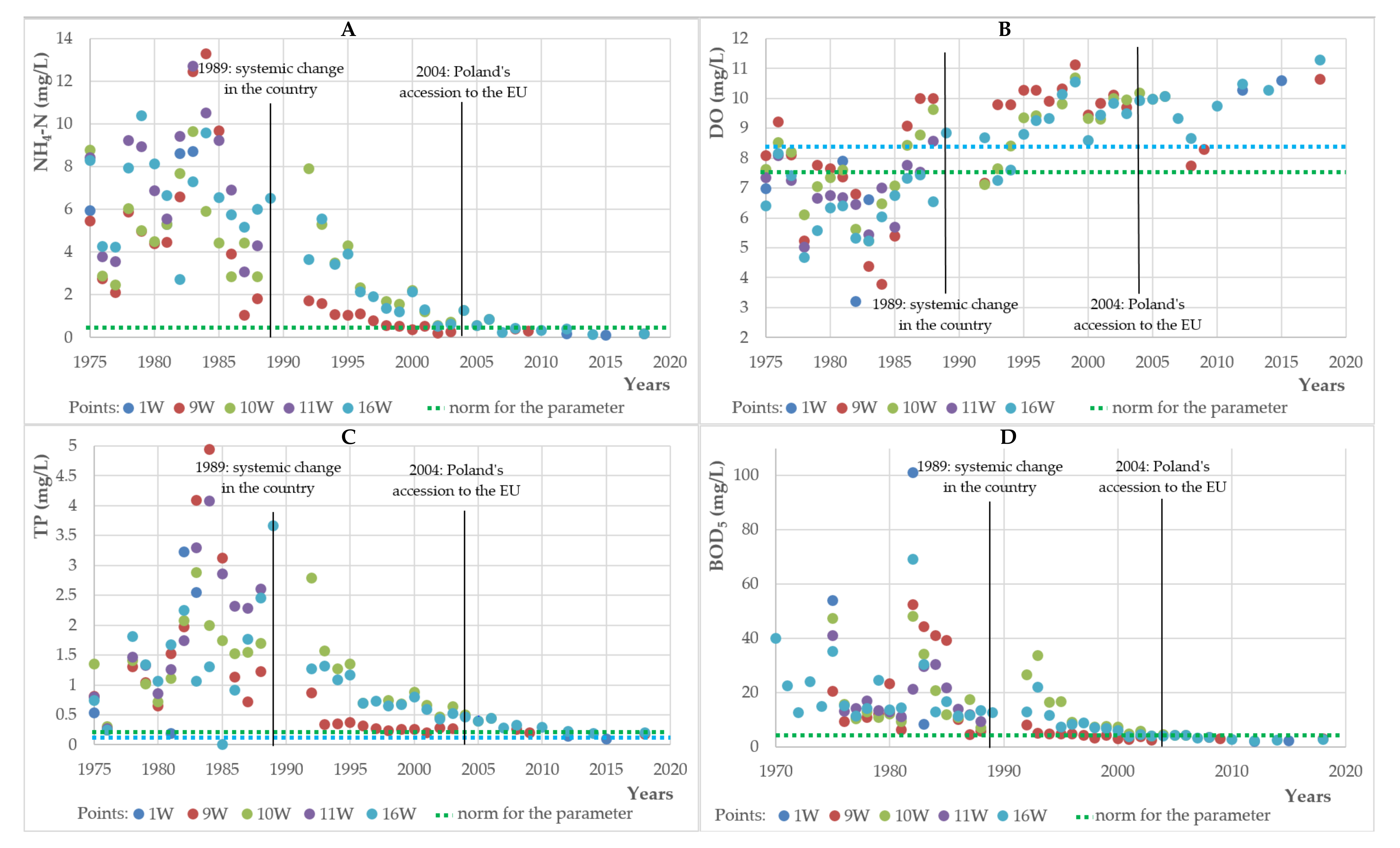
| Point No. | Name of the Point | River km * | This Research | External Tests | Research Period |
|---|---|---|---|---|---|
| 1 W | Bystrzyca River above Czarna Woda River (Kamionna) | 33.5 | X | 1975, 1981–1983, 2012, 2015 | |
| 2 | Sadowice hydropower plant (point above HP) | 26.15 | X | 06.2018 −05.2020 | |
| 3 | Sadowice hydropower plant (point below HP) | 26.05 | X | ||
| 4 | Sadowice hydropower plant (reference point) | 25.95 | X | ||
| 5 | Małkowice—reference point | 22.2 | X | ||
| 6 | Skałka hydropower plant (point above HP) | 20.05 | X | ||
| 7 | Skałka hydropower plant (point below HP) | 19.95 | X | ||
| 8 | Bystrzyca river next to Skałka HP—a natural bed | 20.0 | X | ||
| 9 | Bystrzyca above Strzegomka River (Samotwór) | ||||
| 9 W | Bystrzyca above Strzegomka River (Samotwór) | 17.9 | X | X | 1975–2003 **, 2018 |
| 10 W | Bystrzyca below Strzegomka River (Jarnołtów) | 14.8 | X | 1975–2006 ** | |
| 11 W | Bystrzyca below Leśnica | 7.7 | X | 1975–1989 | |
| 12 | Bystrzyca above the division into a HP canal and a natural bed | 4.15 | X | 06.2018 −05.2020 | |
| 13 | Marszowice hydropower plant (point above HP) | 4.05 | X | 06.2017 −05.2020 | |
| 14 | Marszowice hydropower plant (point below HP) | 3.95 | X | ||
| 15 | Marszowice hydropower plant (reference point) | 3.85 | X | ||
| 16 W | Bystrzyca—estuary to the Odra River (Janówek) | 1.2 | X | 1975–2008 **, 2013, 2018 |
| Name of the HP | River | River Length (km) | Type of HP | Generation (MW) | Type of Turbine | Year of Construction | Fish Ladder | Damming Height (m) |
|---|---|---|---|---|---|---|---|---|
| Marszowice (in Wrocław) | Bystrzyca | 4400 | run-of-river * | 0.385 | Francis | 1912 | N | 3.75 |
| Skałka | Bystrzyca | 19,982 | run-of-river * | 0.07 | Kaplan | before 1939 | N | 2.2 |
| Sadowice | Bystrzyca | 26,050 | run-of-river | 0.06 | Francis | 1921 | N | 1.8 |
| No. | Parameter | This Research | External Tests | Name of the Method | Measurement Range |
|---|---|---|---|---|---|
| 1. | pH | X | X | Potentiometric method | 0.00–14.00 |
| 2. | Electrolytic conductivity (EC) | X | X | Conductometric method | 0.1–2000 mS/cm |
| 3. | Temperature of water | X | X | Temperature sensor | −50.0–199.9 °C |
| 4. | Turbidity | X | Nephelometric method | 0.1–1000 NTU | |
| 5. | Total suspended solids (TSS) | X | Filtration though glass-fibre filters | 0.01–4000 mg/L | |
| 6. | Total dissolved solids (TDS) | X | 0–2000 mg/L | ||
| 7. | Ammonium nitrogen (NH4-N) | X | X | Spectrophotometric method | 0.001–1000 |
| 8. | Nitrate nitrogen (NO3-N) | X | X | 0.1–7.0 | |
| 9. | Nitrite nitrogen (NO2-N) | X | X | 0.001–1.2 | |
| 10. | Kjeldahl nitrogen (KN) | X | Method after mineralization with Se | - | |
| 11. | Total nitrogen (TN) | X | Spectrophotometric method | - | |
| 12. | Total phosphorus (TP) | X | X | 0.001–0.5 PO4-P | |
| 13. | Dissolved oxygen (DO) | X | X | Electrochemical sensor | 0.00–20.00 |
| 14. | Biochemical oxygen demand (BOD5) | X | X | Dilution method | 0.1–2000 |
| 15. | Chemical oxygen demand (COD) | X | Permanganate method | 0.1–1000 | |
| 16. | Sulphates (SO4) | X | Gravimetric method using BaCl | 10–1000 | |
| 17. | Chlorides (Cl) | X | Mohr’s method | 5–400 |
| Physicochemical Parameter | Group of Points | Statistical Parameter | ||||
|---|---|---|---|---|---|---|
| Min. | Max. | Avg. | Mdn. | SD | ||
| pH (-) | Reference points | 6.60 | 8.70 | 7.99 | 8.10 | 0.47 |
| Points above HPs | 6.60 | 8.70 | 7.92 | 8.10 | 0.49 | |
| Points below HPs | 6.60 | 8.60 | 7.98 | 8.10 | 0.46 | |
| EC (µS/cm) | Reference points | 312.0 | 931.0 | 526.6 | 491.5 | 134.1 |
| Points above HPs | 318.0 | 961.0 | 537.1 | 493.0 | 136.9 | |
| Points below HPs | 318.0 | 933.0 | 531.4 | 489.5 | 136.2 | |
| Temperature of water (°C) | Reference points | 0.10 | 22.70 | 11.10 | 9.80 | 6.62 |
| Points above HPs | 0.50 | 21.50 | 11.09 | 9.70 | 6.53 | |
| Points below HPs | 0.10 | 22.60 | 11.37 | 10.00 | 6.49 | |
| Turbidity (NTU) | Reference points | 1.20 | 190.00 | 11.39 | 5.50 | 23.95 |
| Points above HPs | 1.50 | 160.00 | 10.40 | 5.80 | 18.64 | |
| Points below HPs | 1.20 | 115.00 | 9.69 | 5.50 | 16.33 | |
| NH4-N (mg/L) | Reference points | 0.000 | 1.102 | 0.154 | 0.109 | 0.168 |
| Points above HPs | 0.000 | 1.180 | 0.169 | 0.129 | 0.170 | |
| Points below HPs | 0.000 | 1.094 | 0.156 | 0.109 | 0.169 | |
| NO3-N (mg/L) | Reference points | 0.111 | 5.312 | 1.591 | 1.430 | 1.051 |
| Points above HPs | 0.314 | 5.849 | 1.535 | 1.323 | 1.072 | |
| Points below HPs | 0.289 | 4.621 | 1.555 | 1.381 | 0.995 | |
| NO2-N (mg/L) | Reference points | 0.0030 | 0.1368 | 0.0289 | 0.0213 | 0.0240 |
| Points above HPs | 0.0000 | 0.1337 | 0.0290 | 0.0213 | 0.0248 | |
| Points below HPs | 0.0000 | 0.1368 | 0.0281 | 0.0213 | 0.0252 | |
| TP (mg/L) | Reference points | 0.020 | 0.290 | 0.112 | 0.100 | 0.054 |
| Points above HPs | 0.030 | 0.290 | 0.116 | 0.100 | 0.059 | |
| Points below HPs | 0.010 | 1.015 | 0.131 | 0.100 | 0.136 | |
| DO (mg/L) | Reference points | 3.50 | 12.80 | 9.33 | 9.20 | 2.29 |
| Points above HPs | 2.70 | 13.20 | 8.67 | 8.40 | 2.63 | |
| Points below HPs | 3.60 | 12.70 | 9.09 | 9.30 | 2.54 | |
| BOD5 (mg/L) | Reference points | 0.3 | 9.0 | 3.8 | 3.6 | 1.8 |
| Points above HPs | 0.4 | 9.1 | 3.7 | 3.4 | 1.7 | |
| Points below HPs | 0.6 | 10.1 | 3.9 | 3.6 | 1.8 | |
| Parameter | df | Error df | F | p (< 0.05) | ηp2 |
|---|---|---|---|---|---|
| EC | 1.620 | 37.259 | 279.916 | 0.000 * (points 6/7) | 0.924 |
| NO3-N | 2.455 | 56.463 | 27.144 | 0.000 * (13/14) | 0.541 |
| DO | 4.939 | 113.607 | 10.902 | 0.000 * (13/14) | 0.322 |
| pH | 3.941 | 90.649 | 10.314 | 0.000 * (6/7, 13/14) | 0.310 |
| TP | 1.356 | 31.199 | 4.970 | 0.024 * | 0.178 |
| BOD5 | 5.580 | 128.341 | 2.082 | 0.064 | 0.083 |
| NO2-N | 1.572 | 36.147 | 1.525 | 0.232 | 0.062 |
| NH4-N | 1.360 | 31.289 | 1.467 | 0.243 | 0.060 |
| Turbidity | 1.204 | 27.686 | 1.190 | 0.296 | 0.049 |
| Temperature | 1.681 | 31.930 | 0.517 | 0.570 | 0.026 |
| Mean Change below HPs | Sadowice HP (Points 2 and 3) | Skałka HP (Points 6 and 7) | Marszowice HP (Points 13 and 14) | |
|---|---|---|---|---|
| Parameter | ||||
| EC | −1.17% | −2.02% * | −1.51% | |
| NO3-N | 2.40% | −4.97% | 5.50% * | |
| DO | 0.56% | 1.50% | 14.04% * | |
| pH | 0.37% | −0.93% * | 2.16%* | |
| TP | −2.58% | −7.22% | −0.19% | |
| BOD5 | 20.16% | 14.78% | 7.80% | |
| NO2-N | 1.26% | 4.66% | −9.77% | |
| NH4-N | 2.50% | 2.32% | −27.83% * | |
| Turbidity | 5.75% | 5.95% | −7.14% | |
| Temperature | 2.14% | 1.58% | −0.10% | |
| Reference Parameter | Vaikasas et al. 2015 [48] | Valero 2012 [56] | Fantin-Cruz et al. 2015 [61] | This Research | |
|---|---|---|---|---|---|
| pH | 0.17% | from −0.93%* to 2.16% * | |||
| Temperature | 2.73% | from −0.10% to 2.14% | |||
| DO | 7.12% | from 0.56% to 14.04% * | |||
| EC | −7.50% | from −2.02%* to −1.17% | |||
| Turbidity | −38.00% * | from −7.14% to 5.95% | |||
| TP | 0% | −26.97% | −28.00% * | from –7.22% to −0.19% | |
| NO3 | −14.00% * | from −4.97% to 5.50% *1 | |||
| TN | −2.08% | −15.49% | from −5.06% to 3.15% 2 | ||
| Type of hydropower | storage (reservoir) | run‒of‒river | |||
| Damming height | <5 m | 5–15 m | 70 m | 243 m | 1.8–3.75 m |
| Location | Lithuania | Spain | Brazil | Poland | |
| Point | Parameter | ||||||||
|---|---|---|---|---|---|---|---|---|---|
| Temp | EC | pH | NH4-N | NO3-N | NO2-N | TP | DO | BOD5 | |
| 1 W | 20.0 | 432 | 7.4–8.1 | 11.9 | 2.00 | 0.294 | 2.79 | 3.4 | 132 |
| 2 | 20.0 | 505 | 7.0–8.4 | 0.549 | 2.76 | 0.069 | 0.19 | 6.6 | 6.2 |
| 3 | 19.8 | 502 | 7.0–8.4 | 0.530 | 2.72 | 0.069 | 0.21 | 6.3 | 6.0 |
| 4 | 20.0 | 505 | 7.0–8.4 | 0.530 | 2.77 | 0.081 | 0.26 | 6.7 | 7.2 |
| 5 | 19.8 | 499 | 7.0–8.5 | 0.374 | 2.83 | 0.067 | 0.21 | 6.3 | 7.0 |
| 6 | 19.8 | 511 | 7.0–8.5 | 0.425 | 2.78 | 0.066 | 0.19 | 6.5 | 5.6 |
| 7 | 19.7 | 502 | 7.0–8.5 | 0.432 | 2.80 | 0.066 | 0.19 | 6.8 | 6.1 |
| 8 | 19.9 | 503 | 7.0–8.4 | 0.453 | 2.82 | 0.066 | 0.20 | 8.0 | 7.3 |
| 9 | 20.1 | 506 | 6.9–8.4 | 0.348 | 3.22 | 0.063 | 0.17 | 6.0 | 5.8 |
| 9 W | 19.1 | 755 | 6.8–8.3 | 9.825 | 4.71 | 0.370 | 3.05 | 6.5 | 27.8 |
| 10 W | 19.5 | 1188 | 6.8–8.2 | 10.475 | 5.20 | 0.582 | 3.23 | 5.9 | 64.9 |
| 11 W | 20.0 | n/d | 6.4–8.0 | 14.45 | 5.66 | 0.638 | 5.11 | 6.6 | 52.0 |
| 12 | 20.6 | 747 | 7.2–8.5 | 0.489 | 3.64 | 0.068 | 0.21 | 7.3 | 7.4 |
| 13 | 21.0 | 817 | 6.9–8.5 | 0.436 | 3.60 | 0.064 | 0.26 | 3.8 | 7.2 |
| 14 | 21.3 | 804 | 7.1–8.5 | 0.377 | 3.73 | 0.070 | 0.22 | 3.7 | 8.5 |
| 15 | 21.3 | 815 | 7.0–8.6 | 0.346 | 3.78 | 0.067 | 0.21 | 3.6 | 7.5 |
| 16W | 20.3 | 1098 | 6.9‒.8.2 | 10.50 | 5.20 | 0.420 | 2.87 | 6.0 | 36.0 |
| Norms (I and II class) | I: ≤ 22.0 II: ≤ 24.0 | I: ≤ 352 II: ≤ 518 | I: 7.7–8.1 II: 7.3–8.1 | I: ≤ 0.13 II: ≤ 0.563 | I: ≤ 1.0 II: ≤ 2.4 | I: ≤ 0.01 II: ≤ 0.03 | I: ≤ 0.15 II: ≤ 0.27 | I: ≥ 8.4 II: ≥ 7.6 | I: ≤ 2.1 II: ≤ 3.3 |
| Parameter | |||||||
|---|---|---|---|---|---|---|---|
| Point | TSS | TDS | KN | TN | COD-Mn | SO4 | Cl |
| 1 W | 88.0 | 578 | 1.068 | 2.94 | 99.5 | 106.9 | 79.7 |
| 9 W | 143.8 | 738 | 3.59 | 7.42 | 124.9 | 222.0 | 86.0 |
| 10 W | 128.0 | 812 | 12.4 | 15.0 | 34.35 | 272.8 | 90.0 |
| 11 W | 207.5 | 850 | n/d | n/d | 251.7 | 205.4 | 114.5 |
| 16 W | 111.8 | 792 | 9.49 | 11.5 | 27.9 | 260.0 | 97.3 |
| Norms (I and II class) | I: ≤ 11.0 II: ≤ 15.0 | I: ≤ 266 II: ≤ 383 | I: ≤ 1.0 II: ≤ 1.3 | I: ≤ 2.0 II: ≤ 4.1 | I: ≤ 7.8 II: ≤ 9.2 | I: ≤ 28.4 II: ≤ 74.5 | I: ≤ 13.0 II: ≤ 29.8 |
| Parameter | Point Requirement | 2 | 3 | 6 | 7 | 13 | 14 |
|---|---|---|---|---|---|---|---|
| Temperature (98% compliance) | ≤21.5 °C (salmonids S) | + | + | + | + | - (22.0) | - (22.1) |
| ≤28.0 °C (cyprinids C) | + | + | + | + | + | + | |
| max ∆ 1.5 °C (S) | + | + | + | ||||
| max ∆ 3.0 °C (C) | + | + | + | ||||
| DO (100%) | ≥7 mg/L (S) | - (5.9) | - (6.0) | - (6.2) | - (6.4) | - (4.1) | + |
| ≥5 mg/L (C) | + | + | + | + | + | + | |
| pH (95%) | 6–9 (S/C) | + | + | + | + | + | + |
| max ∆ 0.5 (S/C) | + | + | - (0.6) | ||||
| BOD5 (95%) | ≤3 mg/L (S) | - (6.2) | - (6.0) | - (5.6) | - (6.1) | - (7.2) | - (8.5) |
| ≤6 mg/L (C) | - | + | + | - | - | - | |
| TP (95%) | ≤0.2 mg/L (S) | + | - (0.21) | + | + | - (0.26) | - (0.22) |
| ≤0.4 mg/L (C) | + | + | + | + | + | + | |
| NO2 (95%) | ≤0.01 mg/L (S) | - (0.021) | - (0.021) | - (0.020) | - (0.020) | - (0.019) | - (0.021) |
| ≤0.03 mg/L (C) | + | + | + | + | + | + | |
| NH4-N (95%) | ≤0.78 mg/L (S/C) | + | + | + | + | + | + |
| Species | Criterion | Reference(s) |
|---|---|---|
| Salmonids | >5.0 | Lloyd 1992 [76], Bergheim et al. 1978 [87] |
| >5.5 (fish), >7.0 (eggs) | Roberts and Shepherd 1974 [88] | |
| >7.0 (100%), >9.0 (50%) | Stiff et al. 1992 [89] | |
| >6.0 (early life stages), >3.0 | Chapman 1986 [90] | |
| >6.0 (juveniles) | JRB Associates 1984 [91] | |
| >4.8 | EIFAC 1987 [92] | |
| Cyprinids | >5.0 (100%), >7.0 (50%) | Stiff et al. 1992 [89] |
| >2.9 (carp) | Beamish 2011 [93] | |
| Freshwater fish | >5.0 | Coble 1982 [94], Winton et al. 2019 [99] |
| >6.0 (100%) | Lawson 1995 [95] | |
| Daphnia magna | >3.7 (100%) | Homer and Waller 1983 [96] |
| Well-adapted organisms (e.g., cyanobacteria) | >2.0 | Spoor 1990 [97] |
Publisher’s Note: MDPI stays neutral with regard to jurisdictional claims in published maps and institutional affiliations. |
© 2021 by the authors. Licensee MDPI, Basel, Switzerland. This article is an open access article distributed under the terms and conditions of the Creative Commons Attribution (CC BY) license (https://creativecommons.org/licenses/by/4.0/).
Share and Cite
Tomczyk, P.; Wiatkowski, M. The Effects of Hydropower Plants on the Physicochemical Parameters of the Bystrzyca River in Poland. Energies 2021, 14, 2075. https://doi.org/10.3390/en14082075
Tomczyk P, Wiatkowski M. The Effects of Hydropower Plants on the Physicochemical Parameters of the Bystrzyca River in Poland. Energies. 2021; 14(8):2075. https://doi.org/10.3390/en14082075
Chicago/Turabian StyleTomczyk, Paweł, and Mirosław Wiatkowski. 2021. "The Effects of Hydropower Plants on the Physicochemical Parameters of the Bystrzyca River in Poland" Energies 14, no. 8: 2075. https://doi.org/10.3390/en14082075
APA StyleTomczyk, P., & Wiatkowski, M. (2021). The Effects of Hydropower Plants on the Physicochemical Parameters of the Bystrzyca River in Poland. Energies, 14(8), 2075. https://doi.org/10.3390/en14082075







